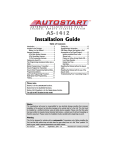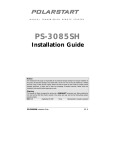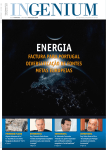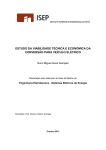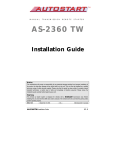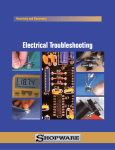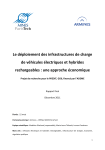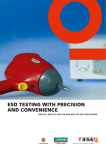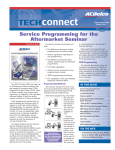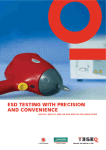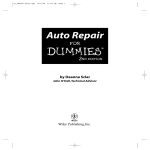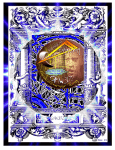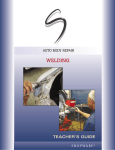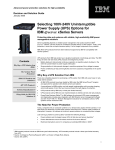Download Instructor`s Guide
Transcript
Hybrid Auto Repair Series 2 • Battery and Safety • Brakes and Service • Computers and Cooling Systems Introduction This Instructor’s Guide provides information to help you get the most out of the Hybrid Auto Repair 2 video series. The contents in this guide will allow you to prepare your students before watching each of the three programs, assist them as they navigate through the programs, and present follow-up activities to reinforce each program’s key learning points. Hybrid Auto Repair Series 2 is a three-part follow-up to the series Hybrid Auto Repair, and takes a closer look at the exciting technology of the hybrid vehicle. Hybrid Auto Repair Series 2 explores the major components that are essential to hybrid automotive technology, presenting an overview of each system component, and reviewing important associated safety requirements to remember when on the job. Various hybrid models are highlighted, as are their oftentimes modelspecific and unique maintenance and service issues, and important safety concerns. Learning Objectives After watching each video program in the series, students will be able to: • Diagnose problems in the high-voltage electrical system, particularly in the battery and battery control modules. • Identify, understand, and follow the unique safety requirements for working with hybrid vehicles, including how to safely power down a hybrid vehicle and charge an AGM battery. • Demonstrate how to perform hydraulic brake maintenance, including using Brake Service Mode on a Ford Escape Hybrid, and Service Mode and Ready Mode in a Toyota Prius. • Identify the differences between standard tires and tires used on hybrid vehicles. • Understand how to properly perform both an active test in Inspection Mode when performing an oil change, and a Compression Test to test the mechanical integrity of the engine. • Demonstrate how to properly rack a hybrid vehicle. • Demonstrate how to diagnose and repair the electric power steering system, and how to change the coolant, air filters, and oil in a hybrid vehicle. National Educational Standards Hybrid Auto Repair Series 2 correlates with the following National Standards: the Program Certification Standards for Automobile Technician Training Programs from the National Institute for Automotive Service Excellence (ASE); the National Standards for the English Language Arts from the National Council of Teachers of English; the National Education Technology Standards from the National Education Technology Standards Project; the National Standards from the National Automotive Technicians Education Foundation (NATEF); and the IHS Global Engineering Standards (Automotive). 2 The content is aligned with the following educational standards and benchmarks from these organizations. Copyright © 2008 Shopware® Language Arts Standards Using these standards, the ASE/NATEF organizations have compiled the following list of language arts and communication skills for automotive service personnel. Using these skills, an automotive technician must be able to: • Request, collect, comprehend, evaluate, and apply oral and written information gathered from customers, associates, and supervisors regarding problem symptoms and potential solutions to problems. • Identify the purpose for all written and oral communication and then choose the most effective strategies for listening, reading, speaking, and writing to facilitate the communication process. • Adapt a reading strategy for all written materials, e.g. customer’s notes, service manuals, shop manuals, technical bulletins, etc., relevant to problem identification, diagnosis, solution, and repair. • Attend to verbal and nonverbal cues in discussions with customers, supervisors, and associates to verify, identify, and solve problems. • Use study habits and techniques, i.e. previewing, scanning, skimming, taking notes, etc., when reviewing publications (shop manuals, references, databases, operator’s manuals, and text resources) for problem solving, diagnosis, and repair. • Use prior knowledge learned from solving similar problems to diagnose and repair specific problems. • Write clear, concise, complete, and grammatically accurate sentences and paragraphs. • Write warranty reports and work orders to include information regarding problem resolution and the results of the work performed for the customer or manufacturer. • Comprehend and apply industry definitions and specifications to diagnose and solve problems in all automotive systems and components. • Follow all oral/written directions that relate to the task or system under study. • Comprehend and use problem-solving techniques and decision trees that are contained in service manuals to determine cause-and-effect relationships. • Scan service manuals and databases to locate specific information for problem-solving purposes. • Use the service manual to identify the manufacturer’s specifications for system parameters, operation, and potential malfunctions. • Interpret charts, tables, or graphs to determine the manufacturer’s specifications for system operation to identify out-of-tolerance systems and subsystems. • Supply clarifying information to customers, associates, parts suppliers, and supervisors. Technology Standards The series will be developed in compliance with the National Education Technology Standards from the National Education Technology Standards Project. Students will: 3 • Be proficient in the use of technology. • Use technology tools to enhance learning, increase productivity, and promote creativity. • Use productivity tools to collaborate in constructing technology-enhanced models, prepare publications, and produce other creative works. • Use telecommunications to collaborate, publish, and interact with peers, experts, and other audiences. • Use a variety of media and formats to communicate information and ideas effectively to multiple audiences. • Use technology to locate, evaluate, and collect information from a variety of sources. National Automotive Technicians Education Foundation (NATEF) COLLISION REPAIR & REFINISH STANDARDS STATEMENTS • STANDARD 1 – The collision repair and refinish technician training program should have clearly stated program goals, related to the needs of the students and employers served. • STANDARD 2 – Program administration should ensure that instructional activities support and promote the goals of the program. • STANDARD 3 – Support material, consistent with both program goals and performance objectives, should be available to staff and students. • STANDARD 6 – Instruction must be systematic and reflect program goals. A task list and specific performance objectives with criterion referenced measures must be used. • STANDARD 7 – Equipment and tools used must be of the type and quality found in the repair industry and must also be the type needed to provide training to meet the program goals and performance objectives. • STANDARD 8 – The physical facilities must be adequate to permit achievement of the program goals and performance objectives. • STANDARD 9 – The instructional staff must have technical competency and meet all state and local requirements for certification. • Standard 3.1 – Service Information Service information with current manufacturer's service procedures and specification data for vehicles manufactured within the last ten (10) years should be available. This information should be accessible to students while working in the lab/shop area. • Standard 3.2 – Multimedia Appropriate up-to-date multimedia materials such as video equipment, transparencies, etc. should be readily available and utilized in the training process. • Standard 3.4 – Periodicals Current general and technical collision repair and refinish magazines and newspapers should be available for student and instructor use. • Standard 3.5 – Student Materials Necessary instructional texts or pertinent material should be available for each student to satisfy the objectives of the mode of instruction used. Basic textbooks should have copyright dates that are not over five (5) years old; specialized textbooks should have copyright dates that are not over three (3) years old. 4 • Standard 6.1 – Program Plan The training plan should progress in logical steps, provide for alternate sequences where applicable, and be made available to each student. • Standard 6.2 – Student Training Plan A training plan for each student should be used indicating the student's training goal(s) and specific steps needed to meet that goal. • Standard 6.4 – Teaching Load The instructor/student ratio and class contact hours should allow time for interaction on a one-to-one basis. • Standard 6.5 – Curriculum All tasks have been given a priority rating. At least 95% of the High Priority - Individual (HP-I) and 90% of the High Priority - Group (HP-G) items in the Task List must be included in the curriculum. Additional tasks may be included to meet the needs of local employers. The Advisory Committee should approve all additional tasks. Instruction on the legal aspects and responsibilities of the collision repair and refinish technician in areas such as Environmental Protection Agency regulations, safety regulations, OSHA regulations (including the ruling on respiratory protection), and other appropriate requirements should be included in the curriculum. Instruction and practice in filling out work order forms, ordering parts, and basic record keeping should be a part of the training program. Tools and equipment must be available to perform the tasks in each of the areas in which certification is requested. • Standard 6.7 – Performance Standards All instruction should be performance based, with an acceptable performance standard stated for each task. These standards should be shared with students and potential employers. Students should demonstrate “hands-on competency” or “mastery” of a task before the instructor verifies a student's performance. • Standard 6.8 – Safety Standards Safety instruction should be given prior to lab/shop work and be an integral part of the training program. A safety test should be included in the training program. Students and instructors should comply with personal and environmental safety practices associated with clothing; respiratory protection; eye protection; hand tools; power equipment; proper ventilation; and the handling, storage, and disposal of chemicals/materials in accordance with local, state, and federal safety and environmental regulations. • Standard 6.14 – Evaluation of Instruction Instructional procedures should be evaluated in a systematic manner. This evaluation should be through regular reviews by students and the administration. Self-evaluation of instruction should also be utilized on a systematic and regular basis. This system should include input from former students and from the Advisory Committee members. Instructional procedures should show responsiveness to the feedback from these evaluations. • Standard 7.1 – Safety Equipment and tools used in the training program must have all shields, guards, and other safety devices in place, operable, and used. Safety glasses must be worn by all students, instructors, and visitors in the lab/shop area while lab is in session. • Standard 7.2 – Quantity and Quality The tools and equipment used in the training program should reflect the program goals and performance objectives. Sufficient tools and equipment should be available for the training offered. The tools and equipment should meet industry quality standards. • Standard 7.5 – Replacement A systematic schedule for replacement should be used to maintain up-to-date tools and equipment at industry and safety standards. Student follow-up and Advisory Committee input should be used in this system. • Standard 8.2 – Safety The facilities should meet all applicable safety standards and an emergency plan should be in place and posted in all classrooms and lab/shops areas. • Standard 8.3 – Maintenance A regular facilities maintenance program should be used to assure facilities are suitable when required for instruction. • Standard 9.1 – Technical Competency The instructor must hold current ASE certification in each collision repair and refinish area they teach and which is being evaluated for program certification. • Standard 9.2 – Instructional Competency/Certification Instructors should meet all state certifying requirements. • Standard 9.3 – Technical Updating Faculty members should be provided technical materials required to maintain their competency. An opportunity should be provided for instructors to return to industry on a regular basis for in-service and skill upgrading. • Standard 9.4 – First Aid The program should have a written policy, approved by the administrator of the school, on First Aid procedures. 5 IHS Global Engineering Standards (Automotive) • GME3191 – Electrical Connectors • GMW3172 – General Specification for Electrical/Electronic Component Analytical/Development/Validation (A/D/V) Procedures for Conformance to Vehicle Environmental, Reliability, Durability, and Performance Requirements • GMW3097 – General Specification for Electrical/Electronic Components and Subsystems, Electromagnetic Compatibility (EMC) • GMW3100 – General Specification for Electrical/Electronic Components and Subsystems; Electromagnetic Compatibility; Verification Part • GMW3091 – General Specification for Vehicles, Electromagnetic Compatibility (EMC) • GMW3094 – General Specification for Electrical/Electronic Components and Subsystems; Electromagnetic Compatibility; Verification Part • NFPA 30A – Code for Motor Fuel Dispensing Facilities and Repair Garages • Q7-K – DaimlerChrysler, Ford Motor Company, and General Motors QS-9000 Quality Requirements 7 Pack (includes AIAG Manuals QS-9000, QSA, APQP, MSA, SPC, and FMEA) State Educational Standards Hybrid Auto Repair Series 2 correlates with the following State Standards: the Career Development and Occupational Studies from the State of New York; ImagineND from the State of North Dakota; and the Texas Essential Knowledge & Skills (TEKS) for Technology Education/Industrial Technology Education from the State of Texas. New York State (Academy for Teaching and Learning: Career Development and Occupational Studies) • Standard 1: Career Development. Students will be knowledgeable about the world of work, explore career options, and relate personal skills, aptitudes, and abilities to future career decisions. • Standard 2: Integrated Learning. Students will demonstrate how academic knowledge and skills are applied in the workplace and other settings. • Standard 3a: Universal Foundation Skills. Students will demonstrate mastery of the foundation skills and competencies essential for success in the workplace. • Standard 3b: Career Majors. Students who choose a career major will acquire the careerspecific technical knowledge/skills necessary to progress toward gainful employment, career advancement, and success in postsecondary programs. North Dakota State (ImagineND) • Standard Number: N.16.0. Career Cluster: Transportation, Distribution and Logistics. Planning, management, and movement of people, materials, and goods by road, pipeline, air, rail and water and related professional and technical support services such as transportation infrastructure planning and management, logistics services, mobile equipment and facility maintenance. 6 7 Texas Essential Knowledge & Skills (TEKS) for Technology Education/Industrial Technology Education • §123.45. Energy, Power, and Transportation Systems (1) The student describes how a systems model can be used to describe energy, power, and transportation activities. The student is expected to: apply the universal systems model to energy, power, and transportation activities; identify the inputs, processes, outputs, and feedback associated with energy, power, and transportation systems; distinguish between various forms of energy; and describe how technological systems interact to achieve common goals. (4) The student investigates emerging and innovative energy, power, and transportation technologies. The student is expected to: report on emerging and innovative energy, power, and transportation technologies; and conduct research and experimentation in energy, power, and transportation technology. (5) The student describes quality and how it is measured in energy, power, and transportation. The student is expected to: describe different quality control applications in energy, power, and transportation; and apply continuous quality improvement techniques to the use and production of energy, power, and transportation. (7) The student works safely with energy, power, and transportation technology. The student is expected to: master relevant safety tests; follow safety manuals, instructions, and requirements; identify and classify hazardous materials and wastes; and dispose of hazardous materials and wastes appropriately. (8) The student describes the importance of maintenance in energy, power, and transportation. The student is expected to: handle and store tools and materials correctly; locate and perform manufacturers' maintenance procedures on selected tools, equipment, and machines; and describe the results of negligent or improper maintenance. (10) The student applies the appropriate codes, laws, standards, or regulations related to energy, power, and transportation technology, such as Occupational Safety and Health Administration (OSHA), National Electrical Code (NEC), American Society for Testing Materials (ASTM), standard symbols, and line weight. The student is expected to: describe the importance of codes, laws, standards, or regulations; identify areas where codes, laws, standards, or regulations may be required; and follow the appropriate codes, laws, standards, or regulations. (11) The student describes the intended and unintended effects of technological solutions. The student is expected to: use an assessment strategy to determine the risks and benefits of technological developments in energy, power, and transportation; describe how technology has affected individuals, societies, cultures, economies, and environments; discuss the international effects of energy, power, and transportation technology; and describe the issues related to regional and community planning and energy, power, and transportation. (12) The student identifies the factors that influence the evolution of energy, power, and transportation technology. The student is expected to: describe how changes in energy, power, and transportation technology affect business and industry; describe how the development and use of energy, power, and transportation technology are influenced by past events; describe change and the factors that affect the adoption or rejection of energy, power, and transportation technology; and describe how and why technology evolves in energy, power, and transportation. (13) The student solves problems, thinks critically, and makes decisions related to energy, power, and transportation technology. The student is expected to: develop or improve an energy, power, and transportation product or service by following a problem-solving strategy; apply critical-thinking strategies to the analysis and evaluation of proposed technological solutions; and apply decision-making techniques to the selection of technological solutions. (15) The student applies his/her communication, mathematics, and science knowledge and skills to energy, power, and transportation activities. The student is expected to: use written, verbal, and visual communication techniques consistent with industry standards; use mathematics concepts in energy, power, and transportation technology; identify and apply science principles used in energy, power, and transportation technology; and use the appropriate units of measure. (16) The student describes basic product and service marketing in energy, power, and transportation. The student is expected to: prepare a marketing plan for a(n) idea, product, or service; and discuss the effect of customer satisfaction on the image of a product or company. (17) The student investigates career opportunities, requirements, and expectations in energy, power, and transportation technology. The student is expected to: identify an area of interest in energy, power, and transportation, and investigate its entry-level and advancement requirements and its growth potential; and describe the type of careers available in energy, power, and transportation technology. Program Summary The Hybrid Auto Repair 2 series lifts the hood on hybrid vehicles to provide an inside look at hybrid technologies, components, and systems. Specialists in the field of hybrid auto repair take the viewers through maintenance and repair procedures, pointing out invaluable tips and safety concerns along the way. Not only are the differences between hybrid and non-hybrid vehicles discussed, but the unique hybrid model-specific procedures and tips are revealed to viewers. The content of each program is targeted to vo-tech students. However, while the program’s look and feel may be targeted to older teens and adult students, this program will not be limited to use by this audience. Hybrid technology is an excitingly new and hot topic to a wide range of groups who want to see it succeed — including the car manufacturers themselves, as well as environmentalists, politicians, consumers seeking the newest innovations (or purchase incentives via the CLEAR Act), and job seekers in the auto technology industry looking to set themselves apart by acquiring knowledge on the latest hybrid technologies. As a result, the information presented in Hybrid Auto Repair Series 2 could be presented at vocational/technical schools or adult education courses that focus on auto repair and maintenance technologies, transportation technology, auto operations and repair, auto safety, auto technology and design, engines, and transportation. 8 The Hybrid Auto Repair 2 series consists of three titles: Battery and Safety; Brakes and Service; and Computers and Cooling Systems. The first title in the series, Battery and Safety, demonstrates how to work on a hybrid’s high-voltage battery with an emphasis on safety every step along the way. Brakes and Service helps viewers gain an understanding of a hybrid’s regenerative brakes, and the procedures involved and modes used in performing hydraulic brake maintenance in a hybrid vehicle. Finally, Computers and Cooling Systems is devoted to the skills needed to service hybrid computer systems, including diagnosing problems in the electric power steering system, changing the coolant safely and correctly in the cooling systems, and changing a hybrid vehicle’s air filters and oil. Main Topics BATTERY AND SAFETY Topic 1: Introduction The program begins with the topic of how to strike a balance between respecting the power of hybrid cars and not being afraid to work on hybrid car components. Topic 2: Hands On: The High-Voltage Battery Kip, the training specialist, takes the battery “hands on,” performing each of the steps necessary to test a battery – including hooking up the scan tool, watching the voltages react on each of the individual battery modules, taking the hybrid car on a test drive, and validating the information to ensure accurate diagnosis. Topic 3: Safety First This section focuses on specific situations in which safety concerns are heightened when working on a hybrid vehicle. Proper safety gear is also highlighted. Topic 4: Powering Down a Hybrid Vehicle The procedures are reviewed for powering down the high-voltage system in order to make a high-voltage repair. Topic 5: Charging the AGM Battery In this section, the special requirements for charging the special Absorbed Glass Mat (AGM) battery, which powers the computer system, are explained. Topic 6: Getting Diagnostic Information The program wraps up with various ways to obtain specific diagnostic information, in order to stay up to date on the most current hybrid vehicle control strategies and service procedures. BRAKES AND SERVICE Topic 1: Introduction The viewer is introduced to a hybrid vehicle’s two braking systems and to what a technician should do when presented with a warning light related to the hybrid’s regenerative brakes. Topic 2: Hydraulic Brake Maintenance In this section, the similarities and differences between hydraulic brake maintenance on a hybrid vehicle, as compared to a standard vehicle, are revealed. Topic 3: Brake Service Mode With particular focus given to Ford hybrid vehicles, experts discuss and demonstrate the steps for properly servicing the brakes on a Ford Escape Hybrid — including putting the car into brake service mode and bleeding the brakes. 9 Topic 4: Tires This section addresses the topic of tires, specifically how — and why — tires on hybrid vehicles differ from those on traditional vehicles. Topic 5: Service Mode Experts in the field shed light on why a hybrid vehicle must be placed in Service Mode before the vehicle is serviced, and demonstrate how to test the vehicle for Ready Mode. Topic 6: Inspection Mode The viewer gains an understanding of which service operations require the engine to remain running, and why placing the hybrid vehicle in Inspection Mode is essential to performing the tasks safely. Topic 7: Compression Test The viewer witnesses a compression test, which tests the mechanical integrity of a hybrid vehicle. Topic 8: Racking the Vehicle The program concludes by addressing the concern about how to rack a hybrid vehicle safely, without inadvertently bringing the metal rack in contact with the high-voltage cable that runs underneath the vehicle. COMPUTERS AND COOLING SYSTEMS Topic 1: Introduction The program opens with the reasons why today’s automotive service specialists need to be “electronics technicians” rather than simply “mechanics.” Topic 2: Scanners and Software Given the complexities of the computer systems in a hybrid vehicle, it is no wonder why specific scanners and software must be used for diagnosis. Various types of both are discussed by the hybrid specialists. Topic 3: Electric Power Steering This section highlights how to diagnose a hybrid’s electric power steering system. Topic 4: Separate Cooling Systems The two separate cooling systems necessary to cool a hybrid vehicle’s two separate sources of power are discussed. Experts demonstrate the many steps involved in changing the coolant safely and correctly. Topic 5: Air Filters and Oil Changes In this section, the viewer gains an understanding of how to change air filters and oil on hybrid vehicles. 10 Topic 6: Hybrids are the Future This final section explores why learning hybrid auto repair is so essential, given not only the continuing growth of hybrid vehicle sales and traditional-to-hybrid conversions, but also the fact that innovative hybrid technologies are increasingly being adopted for mainstream vehicles to improve performance and reduce the environmental impact. Fast Facts • Predictions are that within five years hybrids will capture 15% to 20% of the total automotive market. • In the absence of a scanner to place a hybrid vehicle into inspection mode, a technician can employ a physical sequence involving the gas pedal and shift gears in a prescribed sequence to trick the computer into keeping the engine on. The details for the sequence are contained in the hybrid car’s diagnostic manual. • In 2007, President Bush signed an executive order that required all federal agencies with fleets of 20 motor vehicles or more to reduce their consumption of petroleum by 2% annually through the end of 2015. • On the state level, an executive order known as the Low Carbon Fuel Standard went into effect. Its requirements dictate that fuel suppliers must reduce carbon dioxide emissions levels in vehicles by at least 10% by the year 2020. • While environmentalists applaud the reduced noise pollution from the almost silent running of electric engines, one group is in complete disagreement. The National Federation of the Blind has asked automakers for a minimum sound standard for hybrids to ensure the safety of blind pedestrians, who could be in danger when crossing roads because they could not hear a hybrid car approaching. • In 1997, the first Toyota Prius hit the consumer market; in 2007, there were close to 750,000 in use, with a redesigned next-generation version in the works for a 2008 release. • In this age of hybrid computer systems technology, are car manufacturers worried about people hacking into their systems? It appears that in some cases the hacks are being embraced. A prototype tiny joystick mounted to the shift lever called the Manual Integrated Motor Assist (MIMA) hacks into the Honda Insight control system and allows the driver to use the electric drive to top hills without using the gas pedal, and recharge the battery when the load least affects the mileage. Although this may or may not be implemented, its basic idea has sparked research into optimizing a car’s performance in hilly terrain using algorithms based on topographical maps. • One of the earliest (if not the earliest) examples of a hybrid car was called the “Mixte.” It was built in 1902 by none other than Ferdinand Porsche. • In July 2007, there were 375 hybrid taxis in use in New York City. That number was targeted to become 1,000 by 2008, and grow subsequently by 20% each year. 11 • By 2008, the number of hybrid makes and models is expected to include about 111 sedans and 14 SUVs/vans. As consumers turn “green” but continue to love speed and sleek design, it is anticipated that more and more fuel-efficient yet environmentally friendly sports cars will come to the consumer market in the future. Vocabulary Terms Absorbed Glass Mat (AGM) battery: A sealed 12-volt battery chiefly used to power the computer system. air lock: A tool that puts a vacuum on the cooling system, thereby allowing the proper refill of the coolant without air bubbles on a Toyota Prius. amperage: Measured in amperes (amps), it represents the strength of an electric current. automatic start/shutoff: A feature on some hybrid vehicles that prevents wasted energy from idling by automatically shutting off the engine when the vehicle comes to a stop and restarting it when the accelerator is pressed. battery disconnect switch: A switch that opens or closes the circuit in a hybrid vehicle. bi-directional controls: Controls that send and receive information between one device or component and another. bleeding the brakes: A procedure performed on hydraulic brake systems to remove air bubbles from the brake lines. capacitors: Electrical devices that store energy in the electric field between conductors. cold-cranking amperage (CCA): The rating used to measure a battery’s ability to start an engine in cold temperatures. compression test: A test of the mechanical integrity of the engine to assess its ability to withstand a compressive load. current: A flow of electric charge. digital voltmeter: A tool used for servicing and diagnosing low-voltage circuits. drain cock: A device for draining liquid from a pressurized compartment. electric motor drive/assist: A feature on some hybrid vehicles in which the electric motor provides additional power to assist the engine in accelerating, passing, or hill climbing. This feature allows a smaller, more efficient engine to be used. In some vehicles, the motor alone provides power for low-speed driving conditions where internal combustion engines are least efficient. electric-only mode: Also known as stealth mode, it allows a full hybrid car to drive at low speeds without the engine turning on. 12 electronic control modules: In Ford Escapes and Mercury Mariners, there are five different electronic control modules (the power train control module, the battery control module, the transmission control module, the brake system module, and the power steering system module) that control the hybrid system. All are interconnected in a multiplex communications network. Electronic Control Unit (ECU): On hybrid vehicles, a unit related to the control systems, which contains the hardware and software necessary to control a specific component. Ford Escape hybrid pollen AC filter: A small air filter on the battery pack that blocks out the dirt from the air that cools the battery pack. HEVs (Hybrid Electric Vehicles): Hybrid vehicles that combine an internal combustion engine with a battery and electric motor, offering the extended range and rapid refueling of a conventional vehicle but with the potential for much higher fuel economy. HEV-20: A hybrid car that can travel for 20 miles on one electric charge. hybrid car: A vehicle that has two sources of power: gasoline and electricity. Today's hybrids combine a gasoline engine with one or more electric motors (and a traction battery pack). hybrid car batteries: Two batteries on hybrid vehicles, one of which is the traction battery, and the other of which is an auxiliary 12-volt battery that powers accessories and the car's computer. hybrid car engine: The gasoline combustion engine in a hybrid car. Hybrid Control Unit (HCU): The main center of the hybrid vehicle that controls various aspects and systems within the vehicle including the engine, and the power and brake systems. hybrid tires: Tires that are stiffer than those used on standard vehicles because they need to support the heavier weight of a hybrid vehicle. They are inflated at a higher pressure to last longer, reduce pavement friction, and achieve higher fuel economy. They are sometimes referred to as rolling resistance tires. inspection mode: A mode in a hybrid vehicle that keeps the internal combustion engine running but still allows technicians to work on the hybrid safely. insulation hooks: A safety tool that enables a person to pull a co-worker away from a live cable. insulated safety gloves: Gloves used for performing work with high-voltage batteries. They should be rated at least five hundred volts for maximum safety. inverter (switching box): A device that converts direct current into alternating current. 13 jump-start port: It is possible to jump-start the AGM battery using the jump-start port under the hood, but Toyota recommends you charge the service battery using the recommended sealed battery charger. MasterTech: A specialized scanner with which model-specific cards (e.g., Honda Insight Card) can be used to pull engine-specific codes during maintenance on hybrid vehicles. megohmmeter: A meter used to check the insulation on the high-voltage current lines within the component. plug-in conversion units: A combination of a very advanced battery pack of lithium iron batteries, wiring, and data logging, used primarily in Priuses and Escapes to extend the range that the vehicles run on in electric mode. ready mode: A mode that indicates whether a hybrid vehicle is powered on or off. It is tested for by placing a foot on the brake and seeing whether readying on or turning off is indicated. regenerative braking: A process in which the electric motor applies resistance to the drivetrain, causing the wheels to slow down. In return, the energy from the wheels turns the motor, which functions as a generator, converting kinetic energy normally wasted during coasting and braking into electric energy, and storing the charge in the battery until needed by the electric motor. smart key: On the Toyota Prius, a device that allows automatic locking of the doors and remotestarting of the vehicle. standard OBD-II scanner: A device used to diagnose issues related to the standard on-board diagnostics. Toyota coolant: Coolant used specifically for Toyotas, directly from the coolant bottle; it is not diluted with water, unlike other makes’ coolants. Toyota Prius cooling system: Unlike many other models, the cooling system on a Toyota Prius stores hot coolant in a holding tank in order to keep a section of coolant pre-warmed. This more rapidly warms up the engine when the vehicle is started to lower emissions. transaxle: A component on a vehicle that combines the transmission and differential. transmission (gearbox): The assembly of gears that transmits power from the engine to the driving axle. trickle charger: A small charger that can take 8 or more hours to charge a battery. voltage: Electromotive force, expressed in volts. 14 Pre-Program Discussion Questions 1. How do you think hybrid auto repair technology has changed in 10 years? How about in just the last 2 years? How do you think it will change in the next 10 years? 2. Do you think a high-voltage system in a hybrid is safe? Why or why not? Are there specific cases that you can identify in which safety could be of greater concern? 3. What safety precautions do you think you should take when working with a high-voltage battery or high-voltage cables? 4. Do you think there are any safety issues to remember when racking a vehicle? Discuss. 5. Do you think hydraulic brakes on a hybrid vehicle would last longer than brakes on a traditional vehicle? Why or why not? 6. Do tires in hybrid vehicles differ from those in standard vehicles? Do you think it would be recommended to use standard tires on hybrid vehicles? Why or why not? 7. With what systems do you think the computer network interacts in a hybrid vehicle? Is there any system with which you think it does not interact? 8. What do you think are the main electronic control modules in a hybrid system such as that in the Ford Escape Hybrid or Mercury Mariner? 9. How many cooling systems do you think a hybrid vehicle has? Why do you think it was designed in that manner? 10. Why do you think electric steering that started out in hybrids can now be found in some of the least expensive cars produced today? Post-Program Discussion Questions 1. What safety features are included in a hybrid to help protect the safety of auto technicians? 2. What is an AGM battery, what is its purpose in a hybrid vehicle, and what’s important to remember when performing maintenance or service on it? 3. How do hybrid vehicles’ braking systems work? 4. How do you power off a Toyota Prius and ensure that it is completely off? 5. What is the purpose of “inspection mode”? What about “service mode”? 15 6. Identify and describe the steps necessary to perform a compression test. Why and how does the compression test on a hybrid differ from that on a standard vehicle? How are the steps similar? 7. How do you diagnose the electric power steering system on a hybrid vehicle? For what should you be looking in your diagnosis and data? 8. Identify the various parts and reservoirs of the cooling system and their functions. 9. When you change the coolant on a Toyota hybrid, do you use the same steps that you would on a standard vehicle? Review the steps required and discuss. 10. What is the purpose of the pollen AC filter on the battery pack in a Ford Escape hybrid vehicle, and what can happen if it is allowed to get dirty? Individual Student Projects • Write a paper that addresses the topic of safety in a hybrid vehicle, especially related to the battery. Identify potentially dangerous components and procedures, as well procedures for ensuring the technician’s safety when working on the hybrid. Include supporting photos or graphics of safety gear, or areas of interest on the hybrid vehicles related to safety. • Write a paper or create a presentation that explains how performing a compression test in a hybrid vehicle differs from doing so in a traditional vehicle. Support your statements with photos, graphics, or diagrams. • If a warning light comes on related to a Toyota’s hybrid regenerative brakes, what steps should you take and what should you be on the look-out for? Create a short presentation or paper that runs through the proper course of action. • How does the coolant system in the Toyota Prius differ from that in a standard car? How does the coolant itself differ, and for what reason? Create a small video (or a multimedia project with photos, diagrams, and graphics) that spells out the differences to the viewer. • Create two step-by-step procedure sheets – one for powering down the high-voltage system in a Ford Escape Hybrid, and the other for powering down a Toyota Prius. Both should include every small detail to remember in the process. Group Activities • As a class, review the steps for using a megohmmeter to test the conductors of the components to either the battery or transaxle in a Toyota Prius. 16 • Have half the class test and charge an AGM battery, and the other half test and charge the battery in a traditional vehicle. Ask each group to present the procedures involved. Then, as a class, discuss how the procedures differ, and why that must be the case. • In small groups, create posters that address safety concerns in auto repair, including hybrid safety features, safety gear, and potential danger areas. • Divide the class in half and have one group discuss and then perform an oil change on a Honda Civic hybrid, and the other discuss and then perform one on a Toyota hybrid. Then, as a class, discuss how the procedures differ and why that is so. • If possible, make a class trip to a local hybrid service repair shop to see specialists in the field in action. Upon their return, the students should write down and share any new information they learned that day that they did not know previously. Internet Activities • Using the Internet and talking to your local hybrid service repair shop, investigate who has the most up-to-date diagnostic information on hybrid vehicles. Compare and contrast how the information differs, depending on the source, in a paper or 5-minute presentation to the class. Who has the most current information? • Using the Internet, research how technology that originated in hybrids is – or will soon be — incorporated into standard vehicles, as well. • Research how automotive repair of hybrid vehicles has changed over the last 10 years. • How many different hybrid vehicles are available right now? Create a presentation, slideshow, or project that shows the models, and point out similarities or unique features of the various makes and models. • Research the kinds of scanners and software available today for diagnosing problems in hybrids. Present your findings in a paper, presentation, or slideshow. 17 Assessment Questions Q1. True or false: All hybrids have the same locations for safety plugs and the same procedures to remove them. Q2. Select each true statement: a) Toyota batteries can have anywhere between 200 and 300 volts potential. b) When you pull the safety plug, you are deactivating the system by creating an open circuit. c) An open circuit means that that voltage potential is not there. d) Use a high-voltage meter to check for hot spots, even after the safety plug has been removed. Q3. Which of the following is a true statement regarding an AGM battery? (Select all that apply.) a) It is load tested with 50% of the cold cranking amp for 10 seconds. b) It does not have significant cold cranking amps. c) It acts like a backup battery in a watch. d) It must be tested and charged with expensive equipment that monitors voltage and limits the amount of charge. e) Testing an AGM battery involves applying a constant voltage from beginning to end. Q4. If you are presented with a Prius that has a dead battery, what does Toyota recommend that you should do? (Select all that apply.) a) Use a special sealed battery charger. b) Use a standard charger designed for a sealed lead acid battery, set at a very low amperage rate of 2 – 4 amps. c) Use a small trickle charger and leave it on, unmonitored. d) Jump-start the AGM battery using the jump-start port under the hood. Q5. Which of the following is true about tires on hybrid vehicles? (Select all that apply.) a) Hybrids are outfitted with stiffer tires than standard vehicles. b) Tires are inflated at a higher pressure, which makes them last longer. c) Hybrid tires reduce pavement friction, which results in slightly higher fuel economy. d) If you put a standard tire on a hybrid vehicle, fuel economy is reduced. Hybrid tires must carry a heavier load. e) Some hybrids require special rolling resistance tires, which cost more than standard tires. Q6. How many modes are there when you place your foot on the brake pedal on a Toyota Prius? a) 1 b) 2 c) 3 d) 4 18 Q7. For some service operations, you want to be sure the engine keeps running. And for that, you need to have the hybrid vehicle in ________________ mode. Q8. When working on a Honda Insight hybrid vehicle, which of the following statements is correct regarding the scanner that may be used for diagnostics? (Select all correct answers.) a) Standard OBD2 scanner b) MasterTech scanner with a generic card c) MasterTech scanner with a Honda card d) MasterTech scanner with a Honda Insight card Q9. Which of the following can usually only be done by OEM software (as opposed to aftermarket scanners)? (Select all correct answers.) a) Bi-directional controls b) Electric water pumps c) Turn on AC compressor d) None of these. They can all be done by after-market scanners. Q10. Which of the following is a correct statement about service intervals for changing coolant? (Select all that apply.) a) The intervals are every 50,000 miles for all hybrid vehicles. b) You should consult your shop manual to check the service intervals. c) The intervals can differ depending on the manufacturer. d) The intervals can differ from year to year on the same model. Q11. Hybrid vehicles require which type of oil for maximum fuel economy? b) 5-20 a) 0-20 c) 20-20 d) It depends on the make and model of vehicle. Q12. When you replace the coolant in a Toyota Prius, you’ll need the correct scanner to activate the ___________________________. 19 Q13. What are four keys to properly changing the coolant in a Toyota Prius? (Select all that apply.) a) Use the correct scanner to activate the electric water pump. b) Use an air lock to put a vacuum on the system to ensure air bubbles are not trapped in the system. c) Use special Toyota coolant that is diluted with water. d) Wait 30 minutes for the hot coolant to cool. Q14. True or false: Changing the pollen AC filter on the battery pack of a Ford Escape hybrid vehicle is a complicated procedure. Q15. On which of the following vehicles do you need to ensure you install a primed filter? a) Honda Civic hybrid b) Toyota Prius c) Both of these d) None of these 20 Assessment Questions Answer Key Q1. True or false: All hybrids have the same locations for safety plugs and the same procedures to remove them. A1. This statement is false. Different manufacturers have different locations for these plugs and different procedures to remove them. Q2. Select each true statement: a) Toyota batteries can have anywhere between 200 and 300 volts potential. b) When you pull the safety plug, you are deactivating the system by creating an open circuit. c) An open circuit means that that voltage potential is not there. d) Use a high-voltage meter to check for hot spots, even after the safety plug has been removed. A2. All of these are true statements except for C. C is false because an open circuit does not necessarily mean that that voltage potential is not there. Q3. Which of the following is a true statement regarding an AGM battery? (Select all that apply.) a) It is load tested with 50% of the cold cranking amp for 10 seconds. b) It does not have significant cold cranking amps. c) It acts like a backup battery in a watch. d) It must be tested and charged with expensive equipment that monitors voltage and limits the amount of charge. e) Testing an AGM battery involves applying a constant voltage from beginning to end. A3. The correct answers are B, C, and D. A is false because it relates to a standard battery, not an AGM battery, and E is false because testing an AGM battery involves applying some voltage, waiting to let the plates cool off, and then applying voltage again rather than having one constant driven voltage spike from beginning to end. Q4. If you are presented with a Prius that has a dead battery, what does Toyota recommend that you should do? (Select all that apply.) a) Use a special sealed battery charger. b) Use a standard charger designed for a sealed lead acid battery, set at a very low amperage rate of 2 – 4 amps. c) Use a small trickle charger and leave it on, unmonitored. d) Jump-start the AGM battery using the jump-start port under the hood. A4. The correct answers are A and B. C is not recommended because if you simply leave it on, unmonitored, you’re likely to overheat the battery. D is possible but not recommended by Toyota; once the 12 volt service battery is powered up by the recommended sealed battery charger, the computer can tell the HV battery to crank the engine. 21 Q5. Which of the following is true about tires on hybrid vehicles? (Select all that apply.) a) Hybrids are outfitted with stiffer tires than standard vehicles. b) Tires are inflated at a higher pressure, which makes them last longer. c) Hybrid tires reduce pavement friction, which results in slightly higher fuel economy. d) If you put a standard tire on a hybrid vehicle, fuel economy is reduced. Hybrid tires must carry a heavier load. e) Some hybrids require special rolling resistance tires, which cost more than standard tires. A5. All of these are correct statements. Q6. How many modes are there when you place your foot on the brake pedal on a Toyota Prius? A6. The correct answer is B (2). With your foot on the brake, there are simply two modes: readying on and turning off. Q7. For some service operations, you want to be sure the engine keeps running. And for that, you need to have the hybrid vehicle in ________________ mode. A7. For some service operations, you want to be sure the engine keeps running. And for that, you need to have the hybrid vehicle in inspection mode. Q8. When working on a Honda Insight hybrid vehicle, which of the following statements is correct regarding which the scanner that may be used for diagnostics? (Select all correct answers.) a) Standard OBD2 scanner b) MasterTech scanner with a generic card c) MasterTech scanner with a Honda card d) MasterTech scanner with a Honda Insight card A8. The correct answer is D. A Honda Insight requires a MasterTech scanner with a Honda card for the Insight. Q9. Which of the following can usually only be done by OEM software (as opposed to aftermarket scanners)? (Select all correct answers.) a) Bi-directional controls b) Electric water pumps c) Turn on AC compressor d) None of these. They can all be done by after-market scanners. A9. The correct answers are A, B, and C. Most after-market scanners cannot perform these maintenance functions. 22 Q10. Which of the following is a correct statement about service intervals for changing coolant? (Select all that apply.) a) The intervals are every 50,000 miles for all hybrid vehicles. b) You should consult your shop manual to check the service intervals. c) The intervals can differ depending on the manufacturer. d) The intervals can differ from year to year on the same model. A10. The correct answers are B, C, and D. Q11. Hybrid vehicles require which type of oil for maximum fuel economy? a) 0-20 b) 5-20 c) 20-20 d) It depends on the make and model of vehicle. A11. The correct answer is D. Q12. When you replace the coolant in a Toyota Prius, you’ll need the correct scanner to activate the ____________________________________. A12. When you replace the coolant in a Toyota Prius, you’ll need the correct scanner to activate the electric water pump. Q13. What are four keys to properly changing the coolant in a Toyota Prius? (Select all that apply.) a) Use the correct scanner to activate the electric water pump. b) Use an air lock to put a vacuum on the system to ensure air bubbles are not trapped in the system. c) Use special Toyota coolant that is diluted with water. d) Wait 30 minutes for the hot coolant to cool. A13. The correct answers are A and B. C is incorrect because you must use a special Toyota coolant that is not diluted in water, and D is incorrect because hot coolant stored in a holding tank can stay hot for days at a time, so you must always treat it as if it’s just immediately come off the road. Q14. True or false: Changing the pollen AC filter on the battery pack of a Ford Escape hybrid vehicle is a complicated procedure. A14. This statement is false. It is not a complicated procedure; however, since it is such a tiny filter, a technician may forget to check it. Q15. On which of the following vehicles do you need to ensure you install a primed filter? a) Honda Civic hybrid b) Toyota Prius c) Both of these d) None of these A15. The correct answer is A. If you put a dry filter on a Honda Civic hybrid, and add oil like you would on a normal oil change, you’ll set a code on your computer and have to erase that code with a scanner. On the Toyota Prius, however, you don’t have to worry about whether or not there’s oil in the filter. 23 Additional Resources About Hybrid Cars http://hybridcars.about.com Idaho National Laboratory: Advanced Vehicle Testing Activity http://avt.inel.gov/hev.html Professional Mechanics Online: Hybrid Electric Vehicles www.2carpros.com/hybrid/index.htm Electric Drive Transportation Association www.electricdrive.org Environmental Defense www.environmentaldefense.org EV World: The Future in Motion www.evworld.com Fueleconomy.gov: How Hybrids Work www.fueleconomy.gov/feg/hybridtech.shtml Green Car Congress www.greencarcongress.com/hybrids How Stuff Works: How Hybrid Cars Work www.howstuffworks.com/hybrid-car.htm The Hybrid Experience Report www.hybridexperience.ca Hybrid Cars www.hybridcars.com TreeHugger.com www.treehugger.com National Renewable Energy Laboratory Hybrid Electric and Fuel Cell Vehicles www.nrel.gov/vehiclesandfuels/hev U.S. Department of Energy Technology www.fueleconomy.gov/feg 24 Additional Resources at www.filmsmediagroup.com Available from Films Media Group • www.filmsmediagroup.com • 1-800-257-5126 The Hydrogen Age: Energy Solutions for the 21st Century • • • • Preview clip online at www.films.com Close captioned Correlates to state and national standards VHS/DVD/Digital On-Demand #35025 Leonard Nimoy narrates this wide-ranging documentary on hydrogen-based energy solutions in the U.S. and around the world—including systems that are fully operational as well as those currently in development. Visiting China, Germany, Iceland, and other countries, the program examines the PEM fuel cell and equipment that incorporates fuel cell technology, avoiding fossil fuel consumption and utilizing clean, renewable hydrogen. This dynamic and in-depth video gives special attention to energy advances that can help developing nations improve their economies while reducing pollution and environmental damage. (57 minutes) © 2004. Leaded Gasoline: Trading IQ for Octane • • • • • Preview clip online at www.films.com Close captioned Correlates to state and national standards Winner of the Intermedia-Globe Gold at the WorldMediaFestival, Hamburg, 2005 VHS/DVD/Digital On-Demand #35561 As a gasoline additive, lead suppresses engine knock. Lead is also a well-known poison, and yet during the 1920s it was championed over safer alternatives—and even backed by the U.S. surgeon general. Why? This program presents the history of leaded gasoline and its impact on human health and intelligence, most notably as documented in Herbert Needleman’s controversial study of schoolchildren. Professor Needleman is featured, along with Bill Kovarik, of Radford University; Philippe Grandjean, of the University of Southern Denmark; and Angela Mathee, of the Medical Research Council, Johannesburg. (29 minutes) © 2005. Energy and Resources • Preview clip online at www.films.com • Close captioned • Includes viewable/printable Teacher’s Guide • Correlates to National Science Education Standards, National Educational Technology Standards, and Standards for the English Language Arts • Honorable Mention, Columbus International Film & Video Festival • VHS/DVD/Digital On-Demand #34727 As the Earth’s fossil fuel reserves decline, what forms of energy will come next? After discussing the formation, uses, and consequences of burning coal, oil, and natural gas, this video explores the development of alternative resources that may someday completely replace them: nuclear power, solar energy, biomass, geothermal energy, hydroelectric power, and wind power. Benefits, costs, and environmental impacts are considered. A Cambridge Educational Production. Recommended for grades 7-12. (21 minutes) © 2006. 25 Too Hot Not to Handle: Winning the Battle Against Global Warming • Preview clip online at www.films.com • Close captioned • VHS/DVD/Digital #36244 This film offers a wealth of scientific evidence for dire climate-change predictions—but it also shows how businesses, local governments, and citizens can take positive action to reduce future dangers. With in-depth discussions of what may lie ahead, including increases in storm surges, hurricanes, water pollution, forest fires, and epidemics, the program promotes the urgently needed use of alternative energy sources, such as biodiesel, clean-burning coal, and wind and solar power. Interviews with leading climatologists and environmental health experts enliven the film’s two-pronged focus on perils and solutions. An HBO Production. (55 minutes) © 2006. Conservation and Energy Alternatives: Powering the Future • • • • Preview clip online at www.films.com Close captioned Correlates to state and national standards VHS/DVD/Digital On-Demand #29354 Destabilization in the Middle East and concerns over global warming are heating up the national dialogue on how America intends to power itself into the future. In segment one of this NewsHour program, Michael Marvin, of the Council for Sustainable Energy; Dan Reicher, of the World Resources Institute; Myron Ebell, of the Competitive Enterprise Group; and Herbert Inhaber, author of Why Energy Conservation Fails, consider the big picture. Then, segment two narrows the focus to wind power: improvements in wind farm technology, government incentives and legislation, and rising consumer demand. Drawbacks such as the unpredictability of wind are also considered. (30 minutes) © 2001. Alternative Power Sources and Renewable Energy • Preview clip online at www.films.com • Correlates to state and national standards • VHS/DVD/Digital On-Demand #11164 This program demonstrates how wind turbines, solar cells, hybrid automobiles, and coal gasification plants are beginning to transform the way the world is powered. The U.S. Secretary of Energy, the director of the National Wind Technology Center, the CEO of Enron Wind Corporation, representatives of Worldwatch Institute and the National Renewable Energy Laboratory, and others discuss the challenge of satisfying the rapidly increasing global demand for energy while developing environmentally friendly forms of power generation to reduce air pollution and lessen the threat of global warming. (22 minutes) © 1999. 26 2572 Brunswick Pike, Lawrenceville, NJ 08648 w w w. s h o p w a r e - u s a . c o m Call Toll Free: 800/487-3392 38765



























